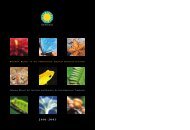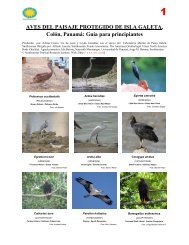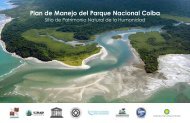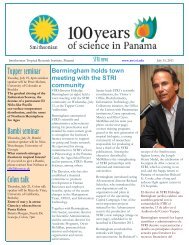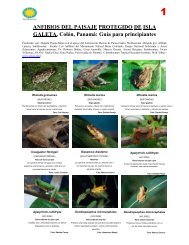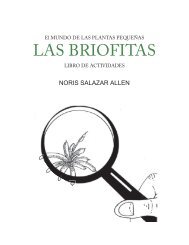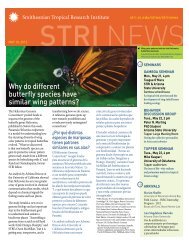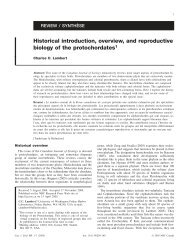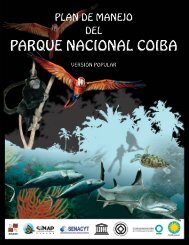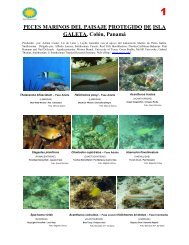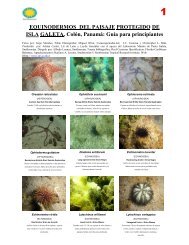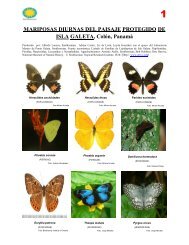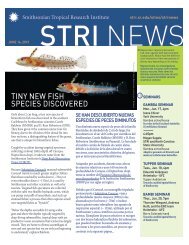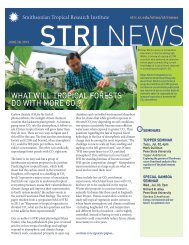Bocas del Toro Research Station - Smithsonian Tropical Research ...
Bocas del Toro Research Station - Smithsonian Tropical Research ...
Bocas del Toro Research Station - Smithsonian Tropical Research ...
Create successful ePaper yourself
Turn your PDF publications into a flip-book with our unique Google optimized e-Paper software.
esearch highlights<br />
11<br />
<strong>Research</strong> at the BRS ranges from deep time to real time, from the tree-tops to the ocean’s<br />
depth, and from ephemeral microbes to ancient corals.<br />
The rise and fall of animal species is tracked<br />
through the origins of the newest coral species<br />
in the Caribbean back to the geological<br />
extinctions of ancient marine animals.<br />
Most projects at the BRS are conducted in a<br />
comparative framework and center on the goals<br />
of the <strong>Smithsonian</strong> Marine Science Network:<br />
Understanding spatial and temporal patterns of<br />
marine biological diversity and the effects of<br />
human activities on them. A minority of studies<br />
focus on physiology, development, or behavior of a<br />
single species, or on applied topics like sustainable<br />
approaches to drug discovery.<br />
Many of the projects at the BRS are linked by a<br />
few common themes. The relative importance of<br />
geographic and ecological or behavioral separation<br />
in the origin of species underlies the work of Oscar<br />
Puebla, Tim Billo and Dave Carlon, as well as the<br />
work on poison dart frogs by Corrine Richards.<br />
The impacts of local development and global<br />
anthropogenic change, such as global warming, are<br />
examined through coral disease and coral bleaching<br />
experiments by Davey Kline, Steve Vollmer, Mary<br />
Alice Coffroth and colleagues; dolphin behavioral<br />
In the local peat swamp forest San San Pond<br />
Sak, a UN World Heritage Site, studies reveal<br />
the role of soil nutrients on tree-species<br />
composition in this rare habitat type.<br />
A wide range of projects address human<br />
impacts on fragile ecosystems. Increases<br />
in sugars associated with pollution have<br />
detrimental effects on members of reef<br />
communities like these sick corals.<br />
observations by Laura May-Collado and colleagues, and<br />
reef community composition by Katie Cramer.<br />
Major efforts are being made to document biodiversity in<br />
the southern Caribbean with current emphasis on algae<br />
(Brian Wyson, Wilson Freshwater, Suzanne Fredericq,<br />
and Jim Norris), mieofauna (Rich Hochberg), shrimps<br />
(Arthur Anker), hydrozoans (Maria Pia Miglietta), and<br />
gastropods (Marta deMaintenon).<br />
In FY06-FY07 the BRS hosted 436 scientific visitors.<br />
They and their projects, and their publications are<br />
listed at the end of this report. Because the more than<br />
100 ongoing projects at the BRS are too numerous and<br />
diverse to describe in full here, this section highlights<br />
the work of students who received fellowships from<br />
the <strong>Smithsonian</strong> Institution and STRI, and projects of<br />
visiting researchers in two important thematic areas:<br />
1) the role of color in mate choice and in the evolution<br />
of new species and 2) mechanisms of the origin and<br />
extinction of marine invertebrates in the Caribbean.



